Religion in national symbols
Religion in national symbols can often be found in national anthems or flags. This has led to controversy in some countries in regard to the separation of church and state, when the national symbol is officially sanctioned by a government. [1]
Flags which incorporate symbols of religion
Christianity
| Flag |
Country |
Religious characteristics |
 |
Armenia (flag) |
The Red emblematizes the maintenance of the Christian faith.[2] |
 |
Andorra (flag) |
Includes a bishop's mitre, representing the Bishop of Urgell.[3] |
 |
Australia (flag) |
Crosses of St. George, St. Andrew and St. Patrick[4] |
 |
Colombia (flag) |
Blue represents the equality of all races and social classes before God and the law[5] |
 |
Denmark (flag) |
Nordic Cross Flag[6] |
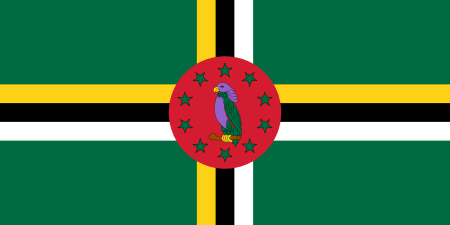 |
Dominica (flag) |
The cross represents the Trinity[7] |
 |
Dominican Republic (flag) |
A Bible, the color white stands for salvation[8] |
 |
El Salvador (flag) |
Dios, Unión, Libertad (God, Union, Liberty) |
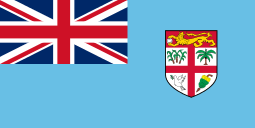 |
Fiji (flag) |
Crosses of St. George, St. Andrew and St. Patrick, dove |
 |
Finland (flag) |
Nordic Cross Flag[6] |
 |
Georgia (country) (flag) |
Jerusalem cross[9] |
 |
Greece (flag) |
The cross symbolizes Greek Orthodoxy[10] |
 |
Iceland (flag) |
Nordic Cross Flag[6] |
 |
Ireland (flag) |
The green symbolizes the Catholic population. The orange symbolizes the Protestants.[11] |
 |
Liechtenstein (flag) |
Christian cross[12] |
 |
Malta (flag) |
George Cross[12] |
 |
Moldova (flag) |
Orthodox Cross |
 |
Montenegro (flag) |
Christian cross[12] |
 |
New Zealand (flag) |
Crosses of St. George, St. Andrew and St. Patrick[12] |
 |
Norway (flag) |
Nordic Cross Flag[6] |
 |
Portugal (flag) |
Compound cross of five quinas, each one charged with five saltire-arranged bezants, representing the five wounds of Christ[13] |
 |
San Marino (flag) |
Cross[12] |
 |
Serbia (flag) |
Orthodox Cross[14] |
 |
Spain (flag) |
Cross[12] |
 |
Sweden (flag) |
Nordic Cross Flag[6] |
 |
Switzerland (flag) |
Christian cross[15] |
 |
Slovakia (flag) |
Patriarchal cross[16] |
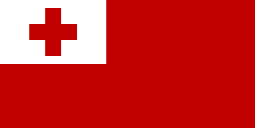 |
Tonga (flag) |
Christian cross[17] |
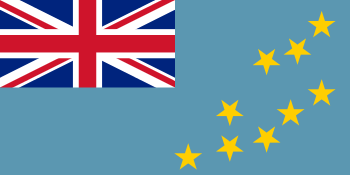 |
Tuvalu (flag) |
Crosses of St. George, St. Andrew and St. Patrick |
 |
United Kingdom (flag) |
Crosses of St. George, St. Andrew and St. Patrick[18] |
 |
Vatican City (flag) |
The flag consists of two vertical bands, one of gold (hoist side) and one of white with the crossed keys of Saint Peter and the Papal Tiara centered in the white band |
Islam
Judaism
Buddhism/Hinduism
Traditional
National anthems which incorporate religion
- Afghanistan
 Milli Tharana (Afghan National Anthem) (Islam)
Milli Tharana (Afghan National Anthem) (Islam)
- Albania
 Himni i Flamurit (Anthem of the Flag) (Islam/Christianity)
Himni i Flamurit (Anthem of the Flag) (Islam/Christianity)
- Antigua and Barbuda
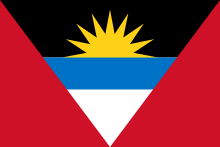 Fair Antigua, We Salute Thee (Christianity)
Fair Antigua, We Salute Thee (Christianity)
- Austria
 Land der Berge, Land am Strome (Land of the Mountains, Land on the River) (Christianity)
Land der Berge, Land am Strome (Land of the Mountains, Land on the River) (Christianity)
- The Bahamas
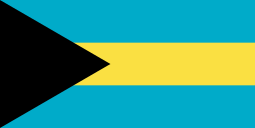 March On, Bahamaland (Christianity)
March On, Bahamaland (Christianity)
- Bahrain
 Bahrainona (Our Bahrain) (Islam)
Bahrainona (Our Bahrain) (Islam)
- Barbados
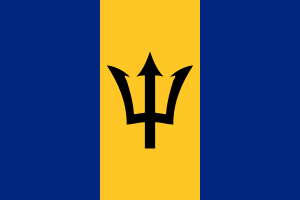 In Plenty and In Time of Need (Christianity)
In Plenty and In Time of Need (Christianity)
- Belarus
 My Belarusy (We Belarusians) (Christianity)
My Belarusy (We Belarusians) (Christianity)
- Belize
 Land of the Free (Christianity)
Land of the Free (Christianity)
- Bolivia
 Himno Nacional de Bolivia (National Anthem of Bolivia) (Christianity)
Himno Nacional de Bolivia (National Anthem of Bolivia) (Christianity)
- Botswana
 Fatshe leno la Rona (Blessed Be This Noble Land) (Christianity)
Fatshe leno la Rona (Blessed Be This Noble Land) (Christianity)
- Brunei
 Allah Peliharakan Sultan (God Bless the Sultan) (Islam)
Allah Peliharakan Sultan (God Bless the Sultan) (Islam)
- Burundi
 Burundi Bwacu (Our Burundi) (Christianity)
Burundi Bwacu (Our Burundi) (Christianity)
- Cambodia
 Nokoreach (Royal Kingdom) (Buddhism)
Nokoreach (Royal Kingdom) (Buddhism)
- Canada
 O Canada (Christianity)
O Canada (Christianity)
- Chad
 La Tchadienne (Song of the Chadian) (Islam)
La Tchadienne (Song of the Chadian) (Islam)
- Chile
 Himno Nacional de Chile (National Anthem of Chile) (Christianity)
Himno Nacional de Chile (National Anthem of Chile) (Christianity)
- Colombia
 Himno Nacional de la República de Colombia (National Anthem of the Republic of Colombia) (Christianity)
Himno Nacional de la República de Colombia (National Anthem of the Republic of Colombia) (Christianity)
- Comoros
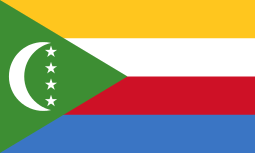 Udzima wa ya Masiwa (The Union of the Great Islands) (Islam)
Udzima wa ya Masiwa (The Union of the Great Islands) (Islam)
- Côte d'Ivoire
 L'Abidjanaise (Song of Abidjan) (Islam/Christianity)
L'Abidjanaise (Song of Abidjan) (Islam/Christianity)
- Czech Republic
 Kde Domov Můj? (Where is my Home?) (Christianity)
Kde Domov Můj? (Where is my Home?) (Christianity)
- Denmark
 Der er et Yndigt Land (There is a Lovely Country) (Traditional)
Der er et Yndigt Land (There is a Lovely Country) (Traditional)
- Dominica
 Isle of Beauty, Isle of Splendour (Christianity)
Isle of Beauty, Isle of Splendour (Christianity)
- DR Congo
 Debout Congolais (Arise Congolese) (Christianity)
Debout Congolais (Arise Congolese) (Christianity)
- Ecuador
 Salve, Oh Patria (We Salute You, Our Homeland) (Christianity)
Salve, Oh Patria (We Salute You, Our Homeland) (Christianity)
- Egypt
 Bilady, Bilady, Bilady (My Homeland, my Homeland, my Homeland) (Islam)
Bilady, Bilady, Bilady (My Homeland, my Homeland, my Homeland) (Islam)
- El Salvador
 Himno Nacional de El Salvador (National Anthem of El Salvador) (Christianity)
Himno Nacional de El Salvador (National Anthem of El Salvador) (Christianity)
- Estonia
 Mu Isamaa, mu Õnn ja Rõõm (My Fatherland, My Happiness and Joy) (Christianity)
Mu Isamaa, mu Õnn ja Rõõm (My Fatherland, My Happiness and Joy) (Christianity)
- Fiji
 God Bless Fiji (Christianity)
God Bless Fiji (Christianity)
- France
 La Marseillaise (The Song from Marseille) (Christianity)
La Marseillaise (The Song from Marseille) (Christianity)
- The Gambia
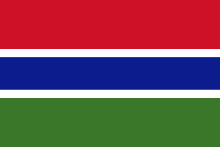 For The Gambia Our Homeland (Islam)
For The Gambia Our Homeland (Islam)
- Ghana
 God Bless Our Homeland Ghana (Christianity)
God Bless Our Homeland Ghana (Christianity)
- Georgia
 Tavisupleba (Freedom) (Christianity)
Tavisupleba (Freedom) (Christianity)
- Grenada
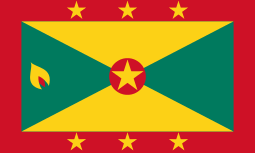 Hail Grenada (Christianity)
Hail Grenada (Christianity)
- Guyana
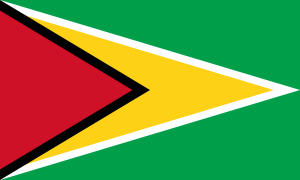 Dear Land of Guyana, of Rivers and Plains (Christianity/Islam/Hinduism)
Dear Land of Guyana, of Rivers and Plains (Christianity/Islam/Hinduism)
- Haiti
 La Dessalinienne (The Dessalines Song) (Christianity)
La Dessalinienne (The Dessalines Song) (Christianity)
- Honduras
 Himno Nacional de Honduras (National Anthem of Honduras) (Christianity)
Himno Nacional de Honduras (National Anthem of Honduras) (Christianity)
- Hungary
 Himnusz (Anthem) (Christianity)
Himnusz (Anthem) (Christianity)
- Iceland
 Lofsöngur (Hymn) (Christianity)
Lofsöngur (Hymn) (Christianity)
- India
 Jana Gana Mana (Thou Art the Ruler of the Minds of All People) (Hinduism/Sikhism/Islam/Christianity/Jainism/Buddhist)
Jana Gana Mana (Thou Art the Ruler of the Minds of All People) (Hinduism/Sikhism/Islam/Christianity/Jainism/Buddhist)
- Indonesia
 Indonesia Raya (Greater Indonesia) (Islam/Christianity/Hinduism/Buddhism/Confusianism/Taoism)
Indonesia Raya (Greater Indonesia) (Islam/Christianity/Hinduism/Buddhism/Confusianism/Taoism)
- Iran
 Sorud-e Melli-e Jomhuri-e Eslami-e Iran (National Anthem of the Islamic Republic of Iran) (Islam)
Sorud-e Melli-e Jomhuri-e Eslami-e Iran (National Anthem of the Islamic Republic of Iran) (Islam)
- Israel
 Hatikvah (The Hope) (Judaism)
Hatikvah (The Hope) (Judaism)
- Italy
 Il Canto degli Italiani (The Song of the Italians) (Christianity)
Il Canto degli Italiani (The Song of the Italians) (Christianity)
- Jamaica
 Jamaica, Land We Love (Christianity)
Jamaica, Land We Love (Christianity)
- Japan
 Kimigayo (His Majesty's Reign) (Shintoism/Buddhism)
Kimigayo (His Majesty's Reign) (Shintoism/Buddhism)
- Jordan
 As-Salam al-Malaki al-Urduni (Peace to the King of Jordan) (Islam)
As-Salam al-Malaki al-Urduni (Peace to the King of Jordan) (Islam)
- Kenya
 Ee Mungu Nguvu Yetu (Oh God of All Creation) (Christianity)
Ee Mungu Nguvu Yetu (Oh God of All Creation) (Christianity)
- Kiribati
 Teirake Kaini Kiribati (Stand Up, Kiribati) (Christianity)
Teirake Kaini Kiribati (Stand Up, Kiribati) (Christianity)
- South Korea
 Aegukga (Patriotic Song) (Christianity/Buddhism)
Aegukga (Patriotic Song) (Christianity/Buddhism)
- Kuwait
 Al-Nasheed Al-Watani (National Anthem) (Islam)
Al-Nasheed Al-Watani (National Anthem) (Islam)
- Latvia
 Dievs, svētī Latviju! (God, Bless Latvia!) (Christianity)
Dievs, svētī Latviju! (God, Bless Latvia!) (Christianity)
- Lebanon
 Ạlnsẖyd Ạlwṭny Ạllbnạny (Lebanese National Anthem) (Christianity/Islam)
Ạlnsẖyd Ạlwṭny Ạllbnạny (Lebanese National Anthem) (Christianity/Islam)
- Lesotho
 Lesotho Fatse La Bontata Rona (Lesotho, Land of our Fathers) (Christianity)
Lesotho Fatse La Bontata Rona (Lesotho, Land of our Fathers) (Christianity)
- Liberia
 All Hail, Liberia, Hail! (Christianity)
All Hail, Liberia, Hail! (Christianity)
- Libya
 Libya, Libya, Libya (Islam)
Libya, Libya, Libya (Islam)
- Liechtenstein
 Oben am jungen Rhein (Up above the young Rhine) (Christianity)
Oben am jungen Rhein (Up above the young Rhine) (Christianity)
- Luxembourg
 Ons Hemecht (Our Homeland) (Christianity)
Ons Hemecht (Our Homeland) (Christianity)
- Madagascar
 Ry Tanindrazanay malala ô! (Oh, Our Beloved Father Land) (Traditional/Christianity)
Ry Tanindrazanay malala ô! (Oh, Our Beloved Father Land) (Traditional/Christianity)
- Malawi
 Mulungu dalitsa Malaŵi (O God bless our land of Malawi) (Christianity)
Mulungu dalitsa Malaŵi (O God bless our land of Malawi) (Christianity)
- Maldives
 Gaumii Salaam (National Salute) (Islam)
Gaumii Salaam (National Salute) (Islam)
- Mali
 Le Mali (Mali) (Islam)
Le Mali (Mali) (Islam)
- Malta
 L-Innu Malti (The Maltese Hymn) (Christianity)
L-Innu Malti (The Maltese Hymn) (Christianity)
- Marshall Islands
 Forever Marshall Islands (Christianity)
Forever Marshall Islands (Christianity)
- Mauritania
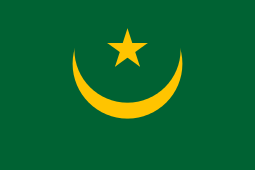 Nshyd Wtny Mwrytany (National Anthem of Mauritania) (Islam)
Nshyd Wtny Mwrytany (National Anthem of Mauritania) (Islam)
- Mauritius
 Motherland (Christianity)
Motherland (Christianity)
- Mexico
 Himno Nacional Mexicano (Mexican National Anthem) (Christianity)
Himno Nacional Mexicano (Mexican National Anthem) (Christianity)
- Micronesia
 Patriots of Micronesia (Christianity)
Patriots of Micronesia (Christianity)
- Monaco
 Hymne Monégasque (Monégasque Anthem) (Christianity)
Hymne Monégasque (Monégasque Anthem) (Christianity)
- Morocco
 Alnshyd Alwtny Almghrby (Cherifian Anthem) (Islam)
Alnshyd Alwtny Almghrby (Cherifian Anthem) (Islam)
- Nauru
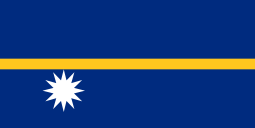 Nauru Bwiema (Nauru, our Homeland) (Christianity)
Nauru Bwiema (Nauru, our Homeland) (Christianity)
- Nepal
 Sayaun Thunga Phool Ka (We are Hundreds of Flowers) (Hinduism/Buddhism)
Sayaun Thunga Phool Ka (We are Hundreds of Flowers) (Hinduism/Buddhism)
- Netherlands
 Wilhelmus (William) (most of the verses contain a link to religion and the 6th verse is entirely devoted to God) (Christianity)
Wilhelmus (William) (most of the verses contain a link to religion and the 6th verse is entirely devoted to God) (Christianity)
- New Zealand
 God Defend New Zealand and God Save the Queen (Christianity)
God Defend New Zealand and God Save the Queen (Christianity)
- Nigeria
 Arise, O Compatriots (Islam/Christianity)
Arise, O Compatriots (Islam/Christianity)
- Norway
 Ja, vi Elsker dette Landet (Yes, we Love this Country) (Christianity)
Ja, vi Elsker dette Landet (Yes, we Love this Country) (Christianity)
- Oman
 Nashid as-Salaam as-Sultani (Royal Anthem of Peace) (Islam)
Nashid as-Salaam as-Sultani (Royal Anthem of Peace) (Islam)
- Pakistan
 Qaumī Tarāna (National Anthem) (Islam)
Qaumī Tarāna (National Anthem) (Islam)
- Palau
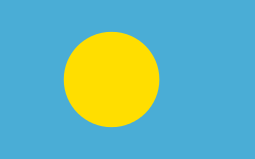 Belau Rekid (Our Palau) (Christianity)
Belau Rekid (Our Palau) (Christianity)
- Panama
 Himno Istmeño (Hymn of the Isthmus) (Christianity)
Himno Istmeño (Hymn of the Isthmus) (Christianity)
- Papua New Guinea
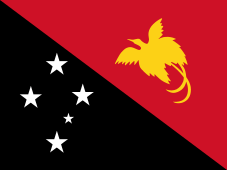 O Arise, All You Sons (Christianity)
O Arise, All You Sons (Christianity)
- Paraguay
 Paraguayos, República o Muerte (Paraguayans, Republic or Death) (Christianity)
Paraguayos, República o Muerte (Paraguayans, Republic or Death) (Christianity)
- Peru
 Himno Nacional del Perú (National Anthem of Peru) (Christianity)
Himno Nacional del Perú (National Anthem of Peru) (Christianity)
- Qatar
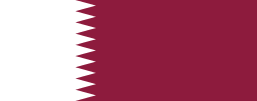 As Salam al Amiri (Peace to the Amir) (Islam)
As Salam al Amiri (Peace to the Amir) (Islam)
- Rwanda
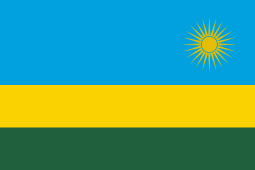 Rwanda Nziza (Beautiful Rwanda) (Christianity)
Rwanda Nziza (Beautiful Rwanda) (Christianity)
- Romania
 Deșteaptă-te, Române! (Awaken, Romanian!) (Christianity)
Deșteaptă-te, Române! (Awaken, Romanian!) (Christianity)
- Russia
 Gosudarstvenny Gimn Rossiyskoy Federatsi (State Anthem of the Russian Federation) (Christianity)
Gosudarstvenny Gimn Rossiyskoy Federatsi (State Anthem of the Russian Federation) (Christianity)
- Saint Kitts and Nevis
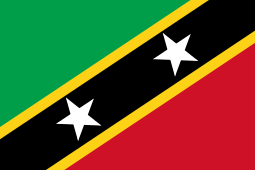 O Land of Beauty! (Christianity)
O Land of Beauty! (Christianity)
- Saint Lucia
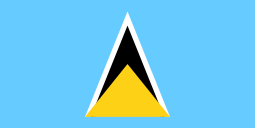 Sons and Daughters of Saint Lucia (Christianity)
Sons and Daughters of Saint Lucia (Christianity)
- Saint Vincent and the Grenadines
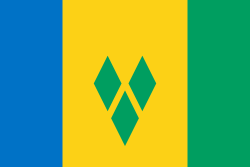 Saint Vincent Land so Beautiful (Christianity)
Saint Vincent Land so Beautiful (Christianity)
- Samoa
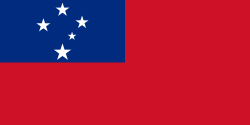 O Le Fu'a o Le Sa'olotoga o Samoa (The Banner of Freedom) (Christianity)
O Le Fu'a o Le Sa'olotoga o Samoa (The Banner of Freedom) (Christianity)
- Saudi Arabia
 Aash Al Maleek (Long Live the King) (Islam)
Aash Al Maleek (Long Live the King) (Islam)
- Senegal
 Pincez Tous vos Koras, Frappez les Balafons (Everyone Strum your Koras, Strike the Balafons) (Islam)
Pincez Tous vos Koras, Frappez les Balafons (Everyone Strum your Koras, Strike the Balafons) (Islam)
- Serbia
 Bože pravde (God of Justice) (Christianity)
Bože pravde (God of Justice) (Christianity)
- Seychelles
 Koste Seselwa (Join together all Seychellois) (Christianity)
Koste Seselwa (Join together all Seychellois) (Christianity)
- Sierra Leone
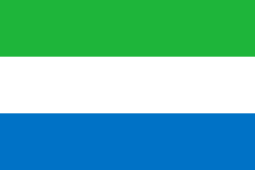 High We Exalt Thee, Realm of the Free (Islam/Christianity)
High We Exalt Thee, Realm of the Free (Islam/Christianity)
- Slovakia
 Nad Tatrou sa Blýska (Lightning over the Tatras) (Christianity)
Nad Tatrou sa Blýska (Lightning over the Tatras) (Christianity)
- Slovenia
 Zdravljica (A Toast) (Christianity)
Zdravljica (A Toast) (Christianity)
- Solomon Islands
 God Save Our Solomon Islands (Christianity)
God Save Our Solomon Islands (Christianity)
- Somalia
 Qolobaa Calankeed (Praise the Homeland) (Islam)
Qolobaa Calankeed (Praise the Homeland) (Islam)
- South Africa
 National Anthem of South Africa (Christianity)
National Anthem of South Africa (Christianity)
- South Sudan
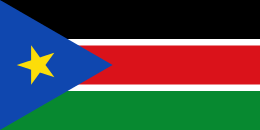 South Sudan Oyee! (Christianity)
South Sudan Oyee! (Christianity)
- Sri Lanka
 Sri Lanka Matha (Mother Sri Lanka) (Buddhism/Hinduism)
Sri Lanka Matha (Mother Sri Lanka) (Buddhism/Hinduism)
- Sudan
 Nahnu Jund Allah Jund Al-watan (We are the Soldiers of God and of our Homeland) (Islam)
Nahnu Jund Allah Jund Al-watan (We are the Soldiers of God and of our Homeland) (Islam)
- Suriname
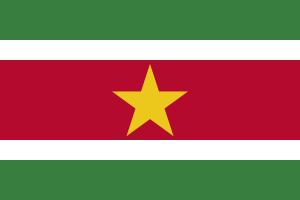 God zij met ons Suriname (God be with our Suriname) (Christianity)
God zij met ons Suriname (God be with our Suriname) (Christianity)
- Swaziland
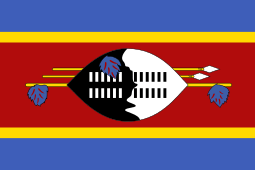 Nkulunkulu Mnikati wetibusiso temaSwati (O Lord is our God, Swaziland) (Christianity)
Nkulunkulu Mnikati wetibusiso temaSwati (O Lord is our God, Swaziland) (Christianity)
- Sweden
 Du gamla, Du fria (Thou ancient, Thou free) (Christianity)
Du gamla, Du fria (Thou ancient, Thou free) (Christianity)
- Switzerland
 Schweizerpsalm/Cantique Suisse/Salmo Svizzero/Psalm Svizzer (Swiss Psalm) (Christianity)
Schweizerpsalm/Cantique Suisse/Salmo Svizzero/Psalm Svizzer (Swiss Psalm) (Christianity)
- Syria
 Humat ad-Diyar (Guardians of the Homeland) (Islam)
Humat ad-Diyar (Guardians of the Homeland) (Islam)
- Tanzania
 Mungu ibariki Afrika (God Bless Africa) (Christianity/Islam)
Mungu ibariki Afrika (God Bless Africa) (Christianity/Islam)
- Togo
 Salut à Toi, Pays de nos Aïeux (Hail to Thee, Land of our Forefathers) (Christianity)
Salut à Toi, Pays de nos Aïeux (Hail to Thee, Land of our Forefathers) (Christianity)
- Tonga
 Ko e fasi 'o e tu'i 'o e 'Otu Tonga (The Song of the King of the Tongan Islands) (Christianity)
Ko e fasi 'o e tu'i 'o e 'Otu Tonga (The Song of the King of the Tongan Islands) (Christianity)
- Trinidad and Tobago
 Forged from the Love of Liberty (Christianity)
Forged from the Love of Liberty (Christianity)
- Tunisia
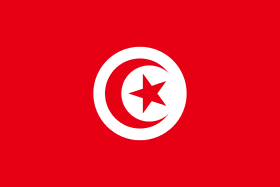 Humat al-Hima (Defenders of the Homeland) (Islam)
Humat al-Hima (Defenders of the Homeland) (Islam)
- Turkey
 İstiklâl Marşı (Independence March) (Islam)
İstiklâl Marşı (Independence March) (Islam)
- Tuvalu
 Tuvalu mo te Atua (Tuvalu for the Almighty) (Christianity)
Tuvalu mo te Atua (Tuvalu for the Almighty) (Christianity)
- United Arab Emirates
 Ishy Bilady (Long Live my Nation) (Islam)
Ishy Bilady (Long Live my Nation) (Islam)
- Uganda
 Oh Uganda, Land of Beauty (Christianity)
Oh Uganda, Land of Beauty (Christianity)
- Uruguay
 Himno Nacional de Uruguay (Christianity)
Himno Nacional de Uruguay (Christianity)
- United Kingdom
 God Save the Queen (Christianity)
God Save the Queen (Christianity)
- United States
 Star Spangled Banner (fourth verse) (Christianity)
Star Spangled Banner (fourth verse) (Christianity)
- Uzbekistan
 O‘zbekiston Respublikasining Davlat Madhiyasi (National Anthem of Uzbekistan) (Islam)
O‘zbekiston Respublikasining Davlat Madhiyasi (National Anthem of Uzbekistan) (Islam)
- Vanuatu
 Yumi, Yumi, Yumi (We, We, We) (Christianity)
Yumi, Yumi, Yumi (We, We, We) (Christianity)
- Vatican City
 Inno e Marcia Pontificale (Hymn and Pontifical March) (Christianity)
Inno e Marcia Pontificale (Hymn and Pontifical March) (Christianity)
- Venezuela
 Gloria al Bravo Pueblo (Glory to the Brave People) (Christianity)
Gloria al Bravo Pueblo (Glory to the Brave People) (Christianity)
- Yemen
 Nashīd al-Yaman al-Watani (National Anthem of Yemen) (Islam)
Nashīd al-Yaman al-Watani (National Anthem of Yemen) (Islam)
- Zambia
 Stand and Sing of Zambia, Proud and Free (Christianity)
Stand and Sing of Zambia, Proud and Free (Christianity)
- Zimbabwe
 National Anthem of Zimbabwe (Christianity)
National Anthem of Zimbabwe (Christianity)
Old anthems
Coat of arms
Christianity
| Coat of arms |
Country |
Religious characteristics |
 |
Andorra (Coat of arms) |
Includes a bishop's mitre, representing the Bishop of Urgell. |
 |
Armenia (Coat of arms) |
Mount Ararat with Noah's Ark sitting atop it. |
 |
Australia (Coat of arms) |
cross, Maltese cross |
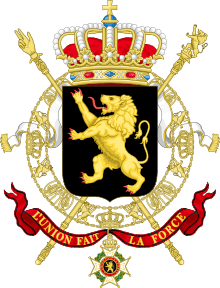 |
Belgium (Coat of arms) |
A globus cruciger on top of the coat of arms as a Christian symbol of authority |
 |
Bulgaria (Coat of arms) |
A globus cruciger on top of the coat of arms as a Christian symbol of authority |
| |
Canada (Coat of arms) |
Cross, 'A Mari Usque Ad Mare' ('From Sea to Sea') |
 |
Denmark (Coat of arms) |
A globus cruciger on top of the coat of arms as a Christian symbol of authority |
 |
Dominican Republic (Coat of arms) |
cross, Bible, 'Dios, Patria, Libertad' ('God, Fatherland, Liberty') |
 |
El Salvador (Coat of arms) |
Dios, Unión, Libertad (God, Union, Liberty) |
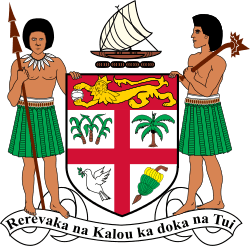 |
Fiji (Coat of arms) |
Cross, 'Rerevaka na kalou ka doka na Tui' ('Fear God and honour the Queen'), dove |
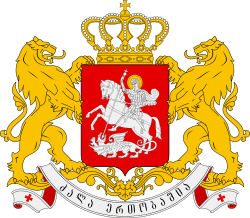 |
Georgia (Coat of arms) |
St. George, Bolnisi cross |
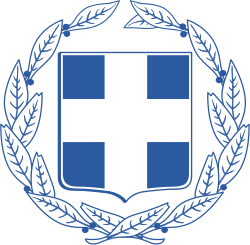 |
Greece (Coat of arms) |
Greek cross |
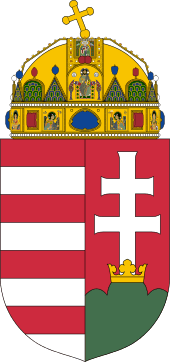 |
Hungary (Coat of arms) |
Patriarchal cross |
 |
Iceland (Coat of arms) |
Nordic cross |
 |
Jamaica (Coat of arms) |
cross |
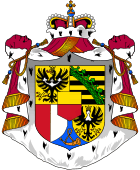 |
Liechtenstein (Coat of arms) |
A globus cruciger on top of the coat of arms as a Christian symbol of authority |
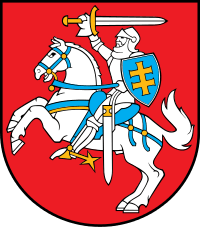 |
Lithuania (Coat of arms) |
Patriarchal cross |
 |
Luxembourg (Coat of arms) |
A globus cruciger on top of the coat of arms as a Christian symbol of authority |
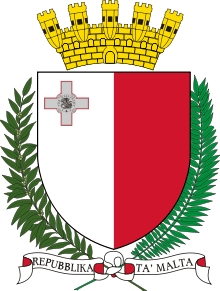 |
Malta (Coat of arms) |
George Cross |
 |
Moldova (Coat of arms) |
cross |
 |
Monaco (Coat of arms) |
cross, 'Deo Juvante' ('With God's Help') |
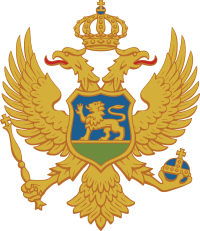 |
Montenegro (Coat of arms) |
cross |
|
Nauru (Coat of arms) |
'God's Will First' |
 |
Netherlands (Coat of arms) |
A globus cruciger on top of the coat of arms as a Christian symbol of authority |
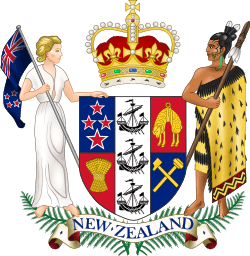 |
New Zealand (Coat of arms) |
A globus cruciger on top of the coat of arms as a Christian symbol of authority |
 |
Nigeria (Coat of arms) |
'Unity and Faith, Peace and Progress' |
 |
Norway (Coat of arms) |
A globus cruciger on top of the coat of arms as a Christian symbol of authority |
 |
Portugal (Coat of arms) |
Compound cross of five quinas, each one charged with five saltire-arranged bezants |
 |
Romania (Coat of arms) |
cross |
 |
Russian Federation (Coat of arms) |
St. George, cross |
 |
Samoa (Coat of arms) |
'Faavae i Le Atua Samoa' ('Samoa is founded on God'), cross |
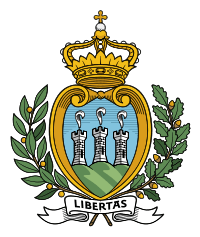 |
San Marino (Coat of arms) |
A globus cruciger on top of the coat of arms as a Christian symbol of authority |
 |
Serbia (Coat of arms) |
Serbian cross |
 |
Slovakia (Coat of arms) |
Patriarchal cross |
 |
Spain (Coat of arms) |
A globus cruciger on top of the coat of arms as a Christian symbol of authority |
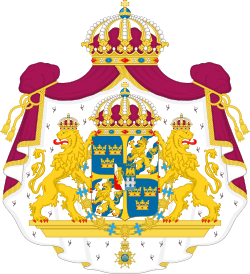 |
Sweden (Coat of arms) |
A globus cruciger on top of the coat of arms as a Christian symbol of authority |
.svg.png) |
Switzerland (Coat of arms) |
cross |
 |
Tonga (Coat of arms) |
cross, dove, 'Ko e ʻOtua mo Tonga ko hoku Tofiʻa' ('God and Tonga are my inheritance') |
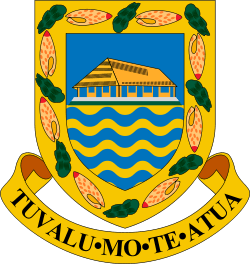 |
Tuvalu (Coat of arms) |
'Tuvalu Mo Te Atua' ('Tuvalu for the Almighty') |
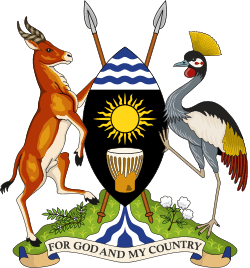 |
Uganda (Coat of arms) |
For God and My Country |
 |
United Kingdom (Coat of arms) |
cross, 'Dieu et mon droit' ('God and my right'), and on Scottish version, 'In My Defens God Me Defend' (shortened to 'In Defens') |
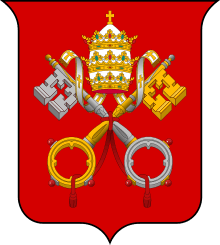 |
Vatican City (Coat of arms) |
The crossed keys of Saint Peter and the Papal Tiara |
 |
Vanuatu (Coat of arms) |
'Long God yumi stanap' ('In God we stand') |
Islam
| Coat of arms |
Country |
Religious characteristics |
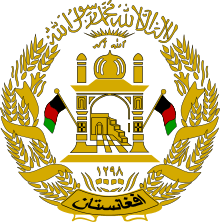 |
Afghanistan (Coat of arms) |
shahadah, mosque, mehrab, Prayer rug |
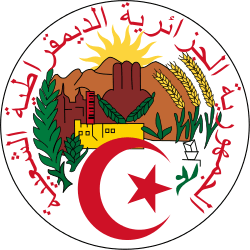 |
Algeria (Coat of arms) |
Star and crescent |
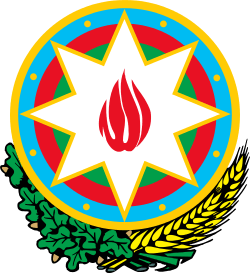 |
Azerbaijan (Coat of arms) |
Calligraphic representation of the name Allah in the form of an Eternal Flame, green |
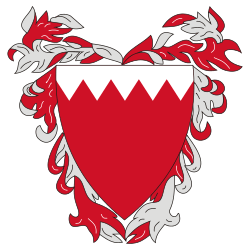 |
Bahrain (Coat of arms) |
five points represent the five pillars of Islam |
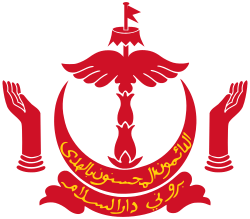 |
Brunei (Coat of arms) |
Crescent moon, الدائمون المحسنون بالهدى (Always in service with God's guidance) |
 |
Comoros (Coat of arms) |
Star and crescent |
 |
Iran (Coat of arms) |
Name of Allah |
_of_Iraq_2008.svg.png) |
Iraq (Coat of arms) |
الله أكبر (God is Great) |
 |
Jordan (Coat of arms) |
Its colours of the eagle signifies the banner of the Prophet Mohammad, the globe signifies the emergence of Islamic civilisation, الراجي من الله التوفيق والعون (Who seeks support and guidance from God) |
 |
Malaysia (Coat of arms) |
Crescent moon |
 |
Maldives (Coat of arms) |
Star and crescent |
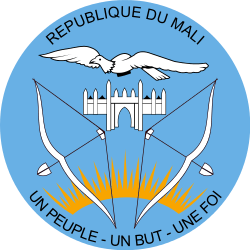 |
Mali (Coat of arms) |
Great Mosque of Djenné, Un Peuple, Un But, Une Foi (One People, One Goal, One Faith) |
 |
Mauritania (Coat of arms) |
Star and crescent, green |
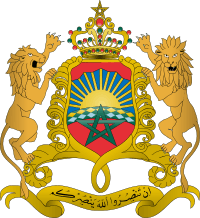 |
Morocco (Coat of arms) |
إن تنصروا الله ينصركم (If you glorify God, he will glorify you) |
 |
Pakistan (Coat of arms) |
ایمان ، اتحاد ، نظم (Faith, Unity, Discipline), Star and crescent, green |
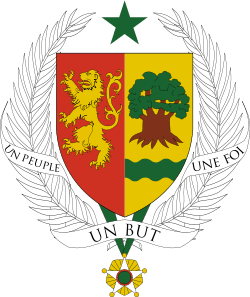 |
Senegal (Coat of arms) |
Un, Peuple, Un But, Une Foi (One People, One Goal, One Faith) |
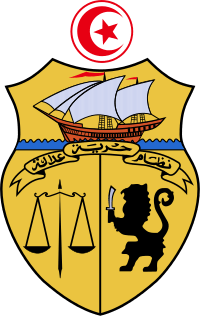 |
Tunisia (Coat of arms) |
Star and crescent |
 |
Turkey (Coat of arms) |
Star and crescent |
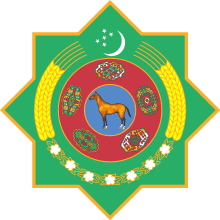 |
Turkmenistan (Coat of arms) |
Rub el Hizb, stars and crescent |
 |
Uzbekistan (Coat of arms) |
Rub el Hizb, star and crescent |
Judaism
Buddhism/Hindiusm
Hinduism
Taoism/Confucianism
Traditional
See also
References
- ↑ http://www.pewresearch.org/fact-tank/2014/11/25/64-countries-have-religious-symbols-on-their-national-flags/
- ↑ "General Information on the government of Armenia's website". Gov.am. Retrieved 2014-02-02.
- ↑ Zartman, Rubin (2002). Power and Negotiation. p. 111. ISBN 0472089072.
- ↑ Foley, Carol A. (1996). The Australian flag : colonial relic or contemporary icon?. Sydney: Federation Press. p. 18. ISBN 9781862871885.
- ↑ "Flag of Colombia on CRW". Crwflags.com. Retrieved 2014-02-02.
- 1 2 3 4 5 Jeroen Temperman. State Religion Relationships and Human Rights Law. Martinus Nijhoff Publishers. Retrieved 2007-12-31.
Many predominantly Christian states show a cross, symbolising Christianity, on their national flag. Scandinavian crosses or Nordic crosses on the flags of the Nordic countries–Denmark, Finland, Iceland, Norway and Sweden–also represent Christianity.
- ↑ "Flag Description: Dominica". World Factbook. CIA. Retrieved June 21, 2013.
- ↑ "Flag Description: Dominican Republic". World Factbook. CIA. Retrieved June 21, 2013.
- ↑ "The new flag of Georgia does not seem to be related with this historical banner. The flag of the National Movement was unknown ten years ago [1993] and was called 'the Georgian historical national flag' by the opposition leaders only after publications by the Georgian vexillologist I.L. Bichikashvili." Mikhail Revnivtsev, 25 November 2003 crwflags.com
- ↑ "Flag Description: Greece". World Factbook. CIA. Retrieved June 21, 2013.
- ↑ Talocci, Mauro (1982). Guide to the Flags of the World. p. 271. ISBN 0688011411.
- 1 2 3 4 5 6 "64 countries have religious symbols on their national flags". Pew Research. Retrieved 2014-12-25.
- ↑ "A Bandeira de Portugal". Portugal (in Portuguese). Criar Mundos. August 2005. Retrieved 2007-02-19.
- ↑ Temperman, Jeroen (2010). State-Religion Relationships and Human Rights Law: Towards a Right to Religiously Neutral Governance. Brill Academic. p. 88. ISBN 9789004181489.
The cross on the flag of Dominica represents Christianity while the three colours of which the cross consists stand for the Trinity. The coat of arms depicted on the flag of Slovakia shows a double cross. The flag of the Dominican Republic represents Christianity while the three colours of which the cross consists stand for the Tinity. The coat of arms depicted on the flag of Slovakia shows a double cross. The flag of the Dominican Republic shows the words "God, Fatherland, Liberty", an opened bible and a cross (depicted in the coat of arms which is represented in the centre). The 'five-cross-flag' of George shows four small crosses and a large St. George's Cross, referring to the patron saint of Georgia (the national flag of England shows the St. George's Cross as well). The white cross on the flag of Greece symbolizes Greek Orthodoxy. The flag of Moldova shows its coat of arms in the centre: an eagle with a Christian Orthodox cross in its beak. The coat of arms of Serbia, as depicted on the national flag, also shows an Orthodox cross.
- ↑ Foley, Carol A. (1 January 1996). The Australian Flag. Federation Press. p. 10. ISBN 9781862871885.
The Christian cross, for instance, is one of the oldest and most widely used symbols in the world, and many European countries, such as the United Kingdom, Norway, Sweden, Finland, Denmark, Iceland, Greece and Switzerland, adopted and currently retain the Christian cross on their national flags.
- ↑ "O štátnej vlajke, štátnej zástave, štátnom znaku a štátnej pečati". Joint Czech–Slovak Digital Parliamentary Library. Chamber of Deputies of the Parliament of the Czech Republic. June 1939. Retrieved 2013-06-23.
- ↑ Smith, Whitney (24 November 2013). "Flag of Tonga". Encyclopedia Britannica. Encyclopedia Britannica, Inc. Retrieved 9 August 2014. (subscription required)
- ↑ "Union Jack". The Royal Household. Retrieved 2013-06-23.
- ↑ "Flag Description: Afghanistan". World Factbook. CIA. Retrieved June 21, 2013.
- ↑ "Flag Description: Algeria". World Factbook. CIA. Retrieved June 21, 2013.
- ↑ "Flag Description: Azerbaijan". World Factbook. CIA. Retrieved June 21, 2013.
- ↑ "Flag Description: Bahrain". World Factbook. CIA. Retrieved June 21, 2013.
- ↑ "Flag Description: Brunei". World Factbook. CIA. Retrieved June 21, 2013.
- ↑ "Flag Description: Comoros". World Factbook. CIA. Retrieved June 21, 2013.
- ↑ "Flag Description: Iran". World Factbook. CIA. Retrieved June 21, 2013.
- ↑ "Flag Description: Iraq". World Factbook. CIA. Retrieved June 21, 2013.
- ↑ "Flag Description: Jordan". World Factbook. CIA. Retrieved June 21, 2013.
- ↑ "Flag of Libya - Description". Index Mundi. Retrieved March 23, 2015.
- ↑ "Flag Description: Malaysia". World Factbook. CIA. Retrieved June 21, 2013.
- ↑ "Flag Description: Maldives". World Factbook. CIA. Retrieved June 21, 2013.
- ↑ "Flag Description: Mauritania". World Factbook. CIA. Retrieved June 21, 2013.
- ↑ "Moroccan Flag". Vexillology Matters. Retrieved March 24, 2015.
- ↑ "Pakistan Flag". Ministry of Information and Broadcasting. Retrieved June 21, 2013.
- ↑ "Flag Description: Saudi Arabia". World Factbook. CIA. Retrieved June 21, 2013.
- ↑ "Senegal on Flagspot". Flagspot.net. Retrieved 2014-02-02.
- ↑ Philip, George and Son (December 26, 2002). Encyclopedic World Atlas. Oxford University Press. p. 198. Retrieved May 24, 2013.
- ↑ World Flags 101. "Sudan Flag - World Flags 101". WorldFlags101.com. Moxy Media. Retrieved 2008-08-09.
- ↑ "Flag Description: Israel". World Factbook. CIA. Retrieved June 21, 2013.
- ↑ "The Constitution of the Kingdom of Bhutan" (PDF). Government of Bhutan. 2008-07-18. Retrieved 2010-10-08.
- ↑ "Flag Description: Cambodia". World Factbook. CIA. Retrieved June 21, 2013.
- ↑ Flags of the world: an illustrated guide to contemporary flags Alfred Znamierowski – 2000, ISBN 1-84215-337-4
- ↑ "The Sri Lankan Lion flag -how it came to be". Virtual Library Sri Lanka.
- ↑ "Flag Description: Thailand". World Factbook. CIA. Retrieved June 21, 2013.
- ↑ "Flag Description: Argentina". World Factbook. CIA. Retrieved June 21, 2013.
- ↑ "Flag of Mexico". All-flags-world.com. Retrieved 2015-07-01.
- ↑ "Flag of Uruguay". All-flags-world.com. Retrieved 2014-02-02.
- ↑ "Flag of Mexico". All-flags-world.com. Retrieved 2015-07-01.
 Milli Tharana (Afghan National Anthem) (Islam)
Milli Tharana (Afghan National Anthem) (Islam) Himni i Flamurit (Anthem of the Flag) (Islam/Christianity)
Himni i Flamurit (Anthem of the Flag) (Islam/Christianity) Fair Antigua, We Salute Thee (Christianity)
Fair Antigua, We Salute Thee (Christianity) Land der Berge, Land am Strome (Land of the Mountains, Land on the River) (Christianity)
Land der Berge, Land am Strome (Land of the Mountains, Land on the River) (Christianity) March On, Bahamaland (Christianity)
March On, Bahamaland (Christianity) Bahrainona (Our Bahrain) (Islam)
Bahrainona (Our Bahrain) (Islam) In Plenty and In Time of Need (Christianity)
In Plenty and In Time of Need (Christianity) My Belarusy (We Belarusians) (Christianity)
My Belarusy (We Belarusians) (Christianity) Land of the Free (Christianity)
Land of the Free (Christianity) Himno Nacional de Bolivia (National Anthem of Bolivia) (Christianity)
Himno Nacional de Bolivia (National Anthem of Bolivia) (Christianity) Fatshe leno la Rona (Blessed Be This Noble Land) (Christianity)
Fatshe leno la Rona (Blessed Be This Noble Land) (Christianity) Allah Peliharakan Sultan (God Bless the Sultan) (Islam)
Allah Peliharakan Sultan (God Bless the Sultan) (Islam) Burundi Bwacu (Our Burundi) (Christianity)
Burundi Bwacu (Our Burundi) (Christianity) Nokoreach (Royal Kingdom) (Buddhism)
Nokoreach (Royal Kingdom) (Buddhism) O Canada (Christianity)
O Canada (Christianity) La Tchadienne (Song of the Chadian) (Islam)
La Tchadienne (Song of the Chadian) (Islam) Himno Nacional de Chile (National Anthem of Chile) (Christianity)
Himno Nacional de Chile (National Anthem of Chile) (Christianity) Himno Nacional de la República de Colombia (National Anthem of the Republic of Colombia) (Christianity)
Himno Nacional de la República de Colombia (National Anthem of the Republic of Colombia) (Christianity) Udzima wa ya Masiwa (The Union of the Great Islands) (Islam)
Udzima wa ya Masiwa (The Union of the Great Islands) (Islam) L'Abidjanaise (Song of Abidjan) (Islam/Christianity)
L'Abidjanaise (Song of Abidjan) (Islam/Christianity) Kde Domov Můj? (Where is my Home?) (Christianity)
Kde Domov Můj? (Where is my Home?) (Christianity) Der er et Yndigt Land (There is a Lovely Country) (Traditional)
Der er et Yndigt Land (There is a Lovely Country) (Traditional) Isle of Beauty, Isle of Splendour (Christianity)
Isle of Beauty, Isle of Splendour (Christianity) Debout Congolais (Arise Congolese) (Christianity)
Debout Congolais (Arise Congolese) (Christianity) Salve, Oh Patria (We Salute You, Our Homeland) (Christianity)
Salve, Oh Patria (We Salute You, Our Homeland) (Christianity) Bilady, Bilady, Bilady (My Homeland, my Homeland, my Homeland) (Islam)
Bilady, Bilady, Bilady (My Homeland, my Homeland, my Homeland) (Islam) Himno Nacional de El Salvador (National Anthem of El Salvador) (Christianity)
Himno Nacional de El Salvador (National Anthem of El Salvador) (Christianity) Mu Isamaa, mu Õnn ja Rõõm (My Fatherland, My Happiness and Joy) (Christianity)
Mu Isamaa, mu Õnn ja Rõõm (My Fatherland, My Happiness and Joy) (Christianity) God Bless Fiji (Christianity)
God Bless Fiji (Christianity) La Marseillaise (The Song from Marseille) (Christianity)
La Marseillaise (The Song from Marseille) (Christianity) For The Gambia Our Homeland (Islam)
For The Gambia Our Homeland (Islam) God Bless Our Homeland Ghana (Christianity)
God Bless Our Homeland Ghana (Christianity) Tavisupleba (Freedom) (Christianity)
Tavisupleba (Freedom) (Christianity) Hail Grenada (Christianity)
Hail Grenada (Christianity) Dear Land of Guyana, of Rivers and Plains (Christianity/Islam/Hinduism)
Dear Land of Guyana, of Rivers and Plains (Christianity/Islam/Hinduism) La Dessalinienne (The Dessalines Song) (Christianity)
La Dessalinienne (The Dessalines Song) (Christianity) Himno Nacional de Honduras (National Anthem of Honduras) (Christianity)
Himno Nacional de Honduras (National Anthem of Honduras) (Christianity) Himnusz (Anthem) (Christianity)
Himnusz (Anthem) (Christianity) Lofsöngur (Hymn) (Christianity)
Lofsöngur (Hymn) (Christianity) Jana Gana Mana (Thou Art the Ruler of the Minds of All People) (Hinduism/Sikhism/Islam/Christianity/Jainism/Buddhist)
Jana Gana Mana (Thou Art the Ruler of the Minds of All People) (Hinduism/Sikhism/Islam/Christianity/Jainism/Buddhist) Indonesia Raya (Greater Indonesia) (Islam/Christianity/Hinduism/Buddhism/Confusianism/Taoism)
Indonesia Raya (Greater Indonesia) (Islam/Christianity/Hinduism/Buddhism/Confusianism/Taoism) Sorud-e Melli-e Jomhuri-e Eslami-e Iran (National Anthem of the Islamic Republic of Iran) (Islam)
Sorud-e Melli-e Jomhuri-e Eslami-e Iran (National Anthem of the Islamic Republic of Iran) (Islam) Hatikvah (The Hope) (Judaism)
Hatikvah (The Hope) (Judaism) Il Canto degli Italiani (The Song of the Italians) (Christianity)
Il Canto degli Italiani (The Song of the Italians) (Christianity) Jamaica, Land We Love (Christianity)
Jamaica, Land We Love (Christianity) Kimigayo (His Majesty's Reign) (Shintoism/Buddhism)
Kimigayo (His Majesty's Reign) (Shintoism/Buddhism) As-Salam al-Malaki al-Urduni (Peace to the King of Jordan) (Islam)
As-Salam al-Malaki al-Urduni (Peace to the King of Jordan) (Islam) Ee Mungu Nguvu Yetu (Oh God of All Creation) (Christianity)
Ee Mungu Nguvu Yetu (Oh God of All Creation) (Christianity) Teirake Kaini Kiribati (Stand Up, Kiribati) (Christianity)
Teirake Kaini Kiribati (Stand Up, Kiribati) (Christianity) Aegukga (Patriotic Song) (Christianity/Buddhism)
Aegukga (Patriotic Song) (Christianity/Buddhism) Al-Nasheed Al-Watani (National Anthem) (Islam)
Al-Nasheed Al-Watani (National Anthem) (Islam) Dievs, svētī Latviju! (God, Bless Latvia!) (Christianity)
Dievs, svētī Latviju! (God, Bless Latvia!) (Christianity) Ạlnsẖyd Ạlwṭny Ạllbnạny (Lebanese National Anthem) (Christianity/Islam)
Ạlnsẖyd Ạlwṭny Ạllbnạny (Lebanese National Anthem) (Christianity/Islam) Lesotho Fatse La Bontata Rona (Lesotho, Land of our Fathers) (Christianity)
Lesotho Fatse La Bontata Rona (Lesotho, Land of our Fathers) (Christianity) All Hail, Liberia, Hail! (Christianity)
All Hail, Liberia, Hail! (Christianity) Libya, Libya, Libya (Islam)
Libya, Libya, Libya (Islam) Oben am jungen Rhein (Up above the young Rhine) (Christianity)
Oben am jungen Rhein (Up above the young Rhine) (Christianity) Ons Hemecht (Our Homeland) (Christianity)
Ons Hemecht (Our Homeland) (Christianity) Ry Tanindrazanay malala ô! (Oh, Our Beloved Father Land) (Traditional/Christianity)
Ry Tanindrazanay malala ô! (Oh, Our Beloved Father Land) (Traditional/Christianity) Mulungu dalitsa Malaŵi (O God bless our land of Malawi) (Christianity)
Mulungu dalitsa Malaŵi (O God bless our land of Malawi) (Christianity) Gaumii Salaam (National Salute) (Islam)
Gaumii Salaam (National Salute) (Islam) Le Mali (Mali) (Islam)
Le Mali (Mali) (Islam) L-Innu Malti (The Maltese Hymn) (Christianity)
L-Innu Malti (The Maltese Hymn) (Christianity) Forever Marshall Islands (Christianity)
Forever Marshall Islands (Christianity) Nshyd Wtny Mwrytany (National Anthem of Mauritania) (Islam)
Nshyd Wtny Mwrytany (National Anthem of Mauritania) (Islam) Motherland (Christianity)
Motherland (Christianity) Himno Nacional Mexicano (Mexican National Anthem) (Christianity)
Himno Nacional Mexicano (Mexican National Anthem) (Christianity) Patriots of Micronesia (Christianity)
Patriots of Micronesia (Christianity) Hymne Monégasque (Monégasque Anthem) (Christianity)
Hymne Monégasque (Monégasque Anthem) (Christianity) Alnshyd Alwtny Almghrby (Cherifian Anthem) (Islam)
Alnshyd Alwtny Almghrby (Cherifian Anthem) (Islam) Nauru Bwiema (Nauru, our Homeland) (Christianity)
Nauru Bwiema (Nauru, our Homeland) (Christianity) Sayaun Thunga Phool Ka (We are Hundreds of Flowers) (Hinduism/Buddhism)
Sayaun Thunga Phool Ka (We are Hundreds of Flowers) (Hinduism/Buddhism) Wilhelmus (William) (most of the verses contain a link to religion and the 6th verse is entirely devoted to God) (Christianity)
Wilhelmus (William) (most of the verses contain a link to religion and the 6th verse is entirely devoted to God) (Christianity) God Defend New Zealand and God Save the Queen (Christianity)
God Defend New Zealand and God Save the Queen (Christianity) Arise, O Compatriots (Islam/Christianity)
Arise, O Compatriots (Islam/Christianity) Ja, vi Elsker dette Landet (Yes, we Love this Country) (Christianity)
Ja, vi Elsker dette Landet (Yes, we Love this Country) (Christianity) Nashid as-Salaam as-Sultani (Royal Anthem of Peace) (Islam)
Nashid as-Salaam as-Sultani (Royal Anthem of Peace) (Islam) Qaumī Tarāna (National Anthem) (Islam)
Qaumī Tarāna (National Anthem) (Islam) Belau Rekid (Our Palau) (Christianity)
Belau Rekid (Our Palau) (Christianity) Himno Istmeño (Hymn of the Isthmus) (Christianity)
Himno Istmeño (Hymn of the Isthmus) (Christianity) O Arise, All You Sons (Christianity)
O Arise, All You Sons (Christianity) Paraguayos, República o Muerte (Paraguayans, Republic or Death) (Christianity)
Paraguayos, República o Muerte (Paraguayans, Republic or Death) (Christianity) Himno Nacional del Perú (National Anthem of Peru) (Christianity)
Himno Nacional del Perú (National Anthem of Peru) (Christianity) As Salam al Amiri (Peace to the Amir) (Islam)
As Salam al Amiri (Peace to the Amir) (Islam) Rwanda Nziza (Beautiful Rwanda) (Christianity)
Rwanda Nziza (Beautiful Rwanda) (Christianity) Deșteaptă-te, Române! (Awaken, Romanian!) (Christianity)
Deșteaptă-te, Române! (Awaken, Romanian!) (Christianity) Gosudarstvenny Gimn Rossiyskoy Federatsi (State Anthem of the Russian Federation) (Christianity)
Gosudarstvenny Gimn Rossiyskoy Federatsi (State Anthem of the Russian Federation) (Christianity) O Land of Beauty! (Christianity)
O Land of Beauty! (Christianity) Sons and Daughters of Saint Lucia (Christianity)
Sons and Daughters of Saint Lucia (Christianity) Saint Vincent Land so Beautiful (Christianity)
Saint Vincent Land so Beautiful (Christianity) O Le Fu'a o Le Sa'olotoga o Samoa (The Banner of Freedom) (Christianity)
O Le Fu'a o Le Sa'olotoga o Samoa (The Banner of Freedom) (Christianity) Aash Al Maleek (Long Live the King) (Islam)
Aash Al Maleek (Long Live the King) (Islam) Pincez Tous vos Koras, Frappez les Balafons (Everyone Strum your Koras, Strike the Balafons) (Islam)
Pincez Tous vos Koras, Frappez les Balafons (Everyone Strum your Koras, Strike the Balafons) (Islam) Bože pravde (God of Justice) (Christianity)
Bože pravde (God of Justice) (Christianity) Koste Seselwa (Join together all Seychellois) (Christianity)
Koste Seselwa (Join together all Seychellois) (Christianity) High We Exalt Thee, Realm of the Free (Islam/Christianity)
High We Exalt Thee, Realm of the Free (Islam/Christianity) Nad Tatrou sa Blýska (Lightning over the Tatras) (Christianity)
Nad Tatrou sa Blýska (Lightning over the Tatras) (Christianity) Zdravljica (A Toast) (Christianity)
Zdravljica (A Toast) (Christianity) God Save Our Solomon Islands (Christianity)
God Save Our Solomon Islands (Christianity) Qolobaa Calankeed (Praise the Homeland) (Islam)
Qolobaa Calankeed (Praise the Homeland) (Islam) National Anthem of South Africa (Christianity)
National Anthem of South Africa (Christianity) South Sudan Oyee! (Christianity)
South Sudan Oyee! (Christianity) Sri Lanka Matha (Mother Sri Lanka) (Buddhism/Hinduism)
Sri Lanka Matha (Mother Sri Lanka) (Buddhism/Hinduism) Nahnu Jund Allah Jund Al-watan (We are the Soldiers of God and of our Homeland) (Islam)
Nahnu Jund Allah Jund Al-watan (We are the Soldiers of God and of our Homeland) (Islam) God zij met ons Suriname (God be with our Suriname) (Christianity)
God zij met ons Suriname (God be with our Suriname) (Christianity) Nkulunkulu Mnikati wetibusiso temaSwati (O Lord is our God, Swaziland) (Christianity)
Nkulunkulu Mnikati wetibusiso temaSwati (O Lord is our God, Swaziland) (Christianity) Du gamla, Du fria (Thou ancient, Thou free) (Christianity)
Du gamla, Du fria (Thou ancient, Thou free) (Christianity) Schweizerpsalm/Cantique Suisse/Salmo Svizzero/Psalm Svizzer (Swiss Psalm) (Christianity)
Schweizerpsalm/Cantique Suisse/Salmo Svizzero/Psalm Svizzer (Swiss Psalm) (Christianity) Humat ad-Diyar (Guardians of the Homeland) (Islam)
Humat ad-Diyar (Guardians of the Homeland) (Islam) Mungu ibariki Afrika (God Bless Africa) (Christianity/Islam)
Mungu ibariki Afrika (God Bless Africa) (Christianity/Islam) Salut à Toi, Pays de nos Aïeux (Hail to Thee, Land of our Forefathers) (Christianity)
Salut à Toi, Pays de nos Aïeux (Hail to Thee, Land of our Forefathers) (Christianity) Ko e fasi 'o e tu'i 'o e 'Otu Tonga (The Song of the King of the Tongan Islands) (Christianity)
Ko e fasi 'o e tu'i 'o e 'Otu Tonga (The Song of the King of the Tongan Islands) (Christianity) Forged from the Love of Liberty (Christianity)
Forged from the Love of Liberty (Christianity) Humat al-Hima (Defenders of the Homeland) (Islam)
Humat al-Hima (Defenders of the Homeland) (Islam) İstiklâl Marşı (Independence March) (Islam)
İstiklâl Marşı (Independence March) (Islam) Tuvalu mo te Atua (Tuvalu for the Almighty) (Christianity)
Tuvalu mo te Atua (Tuvalu for the Almighty) (Christianity) Ishy Bilady (Long Live my Nation) (Islam)
Ishy Bilady (Long Live my Nation) (Islam) Oh Uganda, Land of Beauty (Christianity)
Oh Uganda, Land of Beauty (Christianity) Himno Nacional de Uruguay (Christianity)
Himno Nacional de Uruguay (Christianity) God Save the Queen (Christianity)
God Save the Queen (Christianity) Star Spangled Banner (fourth verse) (Christianity)
Star Spangled Banner (fourth verse) (Christianity) O‘zbekiston Respublikasining Davlat Madhiyasi (National Anthem of Uzbekistan) (Islam)
O‘zbekiston Respublikasining Davlat Madhiyasi (National Anthem of Uzbekistan) (Islam) Yumi, Yumi, Yumi (We, We, We) (Christianity)
Yumi, Yumi, Yumi (We, We, We) (Christianity) Inno e Marcia Pontificale (Hymn and Pontifical March) (Christianity)
Inno e Marcia Pontificale (Hymn and Pontifical March) (Christianity) Gloria al Bravo Pueblo (Glory to the Brave People) (Christianity)
Gloria al Bravo Pueblo (Glory to the Brave People) (Christianity) Nashīd al-Yaman al-Watani (National Anthem of Yemen) (Islam)
Nashīd al-Yaman al-Watani (National Anthem of Yemen) (Islam) Stand and Sing of Zambia, Proud and Free (Christianity)
Stand and Sing of Zambia, Proud and Free (Christianity)  National Anthem of Zimbabwe (Christianity)
National Anthem of Zimbabwe (Christianity).svg.png) Gott erhalte Franz den Kaiser (Christianity)
Gott erhalte Franz den Kaiser (Christianity)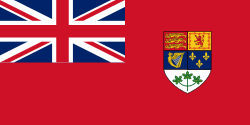 The Maple Leaf Forever (Christianity)
The Maple Leaf Forever (Christianity).svg.png) Es Salaam el Gamhoury el Masry (Islam)
Es Salaam el Gamhoury el Masry (Islam).svg.png) Ityopp'ya Hoy (Ethiopia be Happy) (Christianity)
Ityopp'ya Hoy (Ethiopia be Happy) (Christianity).svg.png) Sorood-e Shahanshahi Iran (Imperial Salute of Iran) (Islam)
Sorood-e Shahanshahi Iran (Imperial Salute of Iran) (Islam).svg.png) Pheng Xat Lao (Buddhism)
Pheng Xat Lao (Buddhism).svg.png) Allahu Akbar (God is Greatest) (Islam)
Allahu Akbar (God is Greatest) (Islam) National Anthem of Manchukuo (Shinto/Buddhism)
National Anthem of Manchukuo (Shinto/Buddhism) Ubavoj nam Crnoj Gori (To Our Beautiful Montenegro) (Christianity)
Ubavoj nam Crnoj Gori (To Our Beautiful Montenegro) (Christianity) Wien Neêrlands Bloed (Those in whom Dutch blood) (Christianity)
Wien Neêrlands Bloed (Those in whom Dutch blood) (Christianity).svg.png) Anthem without a title (Christianity)
Anthem without a title (Christianity)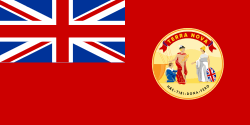 Ode to Newfoundland (Christianity)
Ode to Newfoundland (Christianity) Nigeria, We Hail Thee (Islam/Christianity)
Nigeria, We Hail Thee (Islam/Christianity) Volkslied van de Oranje Vrijstaat (National Anthem of the Orange Free State) (Christianity)
Volkslied van de Oranje Vrijstaat (National Anthem of the Orange Free State) (Christianity).svg.png) Hino da Carta (Hymn to the Charter) (Christianity)
Hino da Carta (Hymn to the Charter) (Christianity) Rise O Voices of Rhodesia (Christianity)
Rise O Voices of Rhodesia (Christianity) Trăiască Regele (Long Live the King) (Christianity)
Trăiască Regele (Long Live the King) (Christianity)_3.svg.png) God Save The Tsar! (Christianity)
God Save The Tsar! (Christianity).svg.png) Die Stem van Suid-Afrika (The Call of South Africa) (Christianity)
Die Stem van Suid-Afrika (The Call of South Africa) (Christianity) Rufst du, mein Vaterland (When you call, my Fatherland) (German version) (Christianity)
Rufst du, mein Vaterland (When you call, my Fatherland) (German version) (Christianity) Gyallu (Buddhism)
Gyallu (Buddhism) Volkslied van Transvaal (National Anthem of the Transvaal) (third verse) (Christianity)
Volkslied van Transvaal (National Anthem of the Transvaal) (third verse) (Christianity)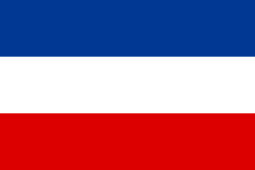 National Anthem of the Kingdom of Yugoslavia (Christianity)
National Anthem of the Kingdom of Yugoslavia (Christianity)